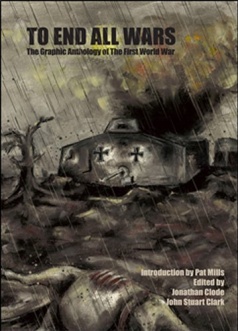This week, we are offering reflections on the six nominees for the 2015 Eisner Award for Best Reality-Based Work, while contemplating larger questions of the variety of ways comics can uniquely crystallize reality for readers.

Edited by Jonathan Clode and John Stuart Clark
Published by Soaring Penguin Press, hardcover, B&W, 330 pages
An omnibus of 27 short graphic narratives based on actual events, characters, circumstances, incidents, myths or consequences of the Great War. Featuring the four theatres of war (land, sea, air and the home front), spanning four continents and drawn from both sides of the conflict, our stories range from four to sixteen pages long, each by a different author and/or illustrator from the world of independent comics. All proceeds from the publication with go to Medicins Sans Frontiers. The beauty of the To End All Wars project is the range of themes it covers, away from the usual focus on the Western Front. “We have dramatic reconstructions of the war in the Atlantic that could have come straight out of Steve Ditko’s vault of horror<” outline Jonathan and Brick on the project’s web site. “We have the story of combatants’ affection and need for pets in the trenches, related exclusively in pictures . We have the obligatory war poet’s story, but that of a Welsh hill farmer rather than some bit of posh who’s been done to death. And we have a feminist take on the controversial Mata Hari and the very personal story of an author’s search for their great grandfather’s memorial.
Turning to the historiographical, rather than autobiographical, portion of the “reality-based” Eisner nominees, it’s appropriate to start with the thick anthology that’s hard to find on American shelves and the closest to the experience of slogging through muddy trenches among this group of great comics. The introduction by Pat Mills (of 2000AD and Charley’s War) declares, “This anthology you have in your hands is an important one because comics are one of the few media voices the establishment has yet to muzzle, doubtless because they think they don’t matter.” Redounding this importance is the fact that it’s (a) an anthology (b) of diverse settings and fronts and contexts (c) with very different vantage points and story types of (d) a complex and many-sided historical moment.
Part of Mills’ polemic is that a centralizing and nationalistic mediascape prods and manipulates the British historical memory towards a particular legitimating narrative of Great Britain in World War One. If such a narrowing and simplifying of the story is occurring (and when is it not?), the role of the anthology is more than just a launchpad or gathering place of shorter works with small ambitions. An anthology can be a statement, a commitment to multiple voices and multiple stories. Anyone carrying around reductive images of where the war took place or who participated in it needs only to browse the book to be reminded of the recruitment offices and POW hospitals, the patriotic parades and diplomatic charades, the trench poets and U-boats, the nameless infantrymen and Mata Hari’s, and the cats and elephants to boot. Anthologies resist simplistic harmonization, maybe especially comics anthologies, and To End All Wars is one of those projects that prizes the proliferation of perspectives that anthologies can afford.
Which sometimes makes for disorienting, tiring, disruptive reading. It’s not meant to go down smooth or lull comfortably into rhythm. It’s a cacophony of incompatible voices that reminds us that the command we have over instruments of death does not give us command over the expanse and variety of life. As with most anthologies, mileage will vary. But as a representative of the kind of “reality” that comics might commit to the record, To End All Wars reminds us what a resource comics can be in our cultures, a pen-and-paper visual storytelling medium as accessible and potent as a Molotov, with the energy potential to push back against aggrandizing meta-narratives. In this case, maybe the Eisners should go plural: “Best Realities-Based Work,” and gesture towards the heterogeneity of histories that comics are growing to capture.
Up next (tomorrow), another take on World War I by Nathan Hale, this time featuring talking animals, “Nathan Hale’s Hazardous Tales: Treaties, Trenches, Mud, and Blood.” You can keep up with the entire week’s look at the 2015 Eisner nominations for Best Reality Based Work here.





